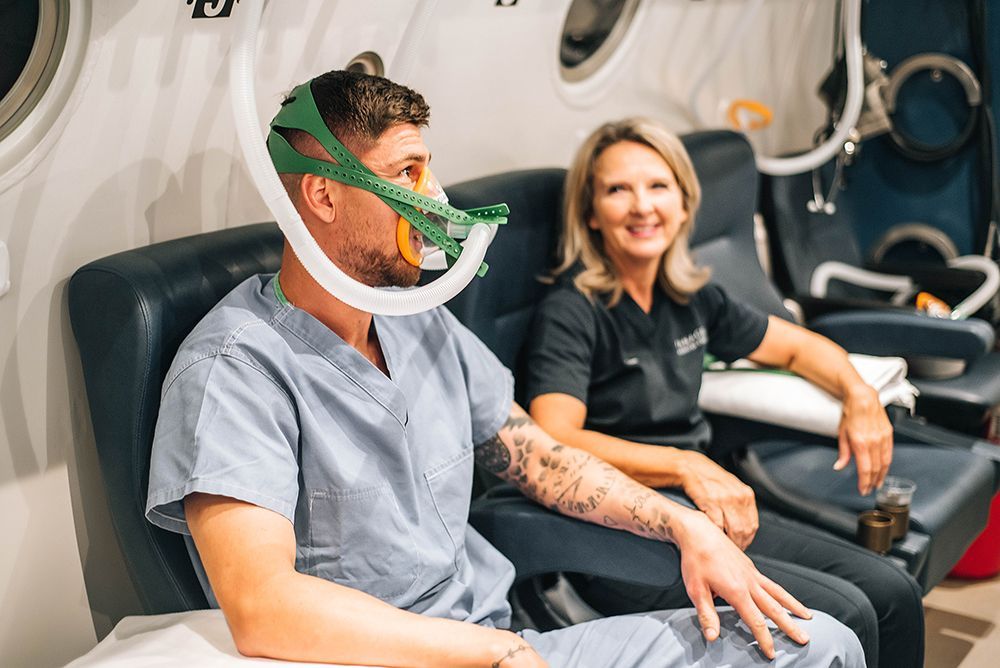Hyperbaric Oxygen Therapy currently have 14 conditions that are FDA approved for treatment.
Hyperbaric Oxygen Therapy currently have 14 conditions that are FDA approved for treatment. The newest one received approval on October 8, 2011. These FDA approved conditions include:
- Air or Gas Embolism
- Carbon Monoxide Poisoning
- Clostridial Myositis and Myonecrosis (Gas Gangrene)
- Crush Injuries, Compartment Syndrome and Other Acute Traumatic Ischemia
- Decompression Sickness
- Arterial Insufficiencies, such as Central Retinal Artery Occlusion
- Severe Anemia
- Intracranial Abscess
- Necrotizing Soft Tissue Infections
- Osteomyelitis (Refractory)
- Delayed Radiation Injury (Soft Tissue and Bony Necrosis)
- Compromised Grafts and Flaps
- Acute Thermal Burn Injury
- Idiopathic Sudden Sensorineural Hearing Loss
Because Hyperbaric Oxygen Therapy is still gaining in popularity and usage, clinical studies for all the potential conditions it may benefit have yet to meet FDA standards. This does not, however, mean that Hyperbaric Oxygen Therapy does not help or treat these conditions. In many cases, there are studies that show promising results and benefits already, but they are not enough. Current conditions that show promise include Reflex Sympathetic Dystrophy (RSD) (also known as Complex Regional Pain Syndrome, or CRPS), Lyme Disease, Alzheimer’s Disease, Multiple Sclerosis, Macular Degeneration, and many more.
The term “FDA Approved” is something you may be familiar with. In contrast, a drug or treatment receives the term “Off-Label” when doctors use it to treat a condition that is not FDA approved. Hyperbaric Oxygen Therapy treatment is only approved for the 14 different medical conditions listed above. However, physicians and researchers see positive results in many more conditions. Therefore, we treat off-label conditions on a daily basis. This practice is not new to medicine. It would amaze you at how many conditions find relief through off label use every day.
There is one downside to off-label treatments with Hyperbaric Oxygen Therapy. Insurance companies typically do not cover HYPERBARIC OXYGEN THERAPY treatments that are not FDA approved. Despite numerous studies and proven success with off-label treatments, coverage is usually denied. Unfortunately, it may be a long time before many conditions receive approval. Patents on hyperbaric chambers ran out a long time ago, so there is not a lot of money in Hyperbaric Oxygen Therapy, Unlike with new pharmaceuticals. Funding for the studies necessary to receive new FDA approval is not available. After treating patients with off-label conditions for many years, Dr. Irina Pavlik Marangos is confident in Hyperbaric Oxygen Therapy and its ability to help thousands of patients in Cyprus.
Off Label treatments that Hyperbaric Oxygen Therapy helps with, unfortunately not covered by most insurances.
- Alzheimer’s
- Autism
- Cancer
- Cerebral Palsy
- Fibromyalgia
- Lyme Disease
- Migraines
- Mold Exposure and Toxicity
- Multiple Sclerosis
- Post-Traumatic Stress Disorder
- Stroke
- Traumatic Brain Injuries
- Wound Care
Alzheimer’s
Hyperbaric oxygen therapy delivers 100 percent oxygen at increased air pressure. This allows for oxygen to flood the body’s blood, cells, and tissues. Because Alzheimer’s disease is the result of abnormalities in the brain, researchers believe that flooding the brain with increased oxygen levels will have positive results. A study published in 2018 showed just that. Researchers from Tel Aviv University administered Hyperbaric Oxygen Therapy sessions to transgenic mice, or mice engineered to develop Alzheimer’s. They underwent two weeks of daily Hyperbaric Oxygen Therapy sessions. Their results show that Hyperbaric Oxygen Therapy treatments reduce oxygen starvation and inflammation in the brain. It also reduces the burden of amyloid plaques, as well as shows a decrease in tau tangles. The researchers saw observable changes and improvements in behavioral symptoms.
Autism
There is currently no cure for autism spectrum disorders and standard treatment options focus on improving behavior and reducing symptoms. Because of this, many physicians look for alternative treatment options that offer additional help. Hyperbaric Oxygen Therapy , is one such alternative that shows great promise in treating autism. By treating damage and inflammation in the brain, Hyperbaric Oxygen Therapy targets the source of the condition. As a result, many researchers, parents, and those living with autism see amazing results. To date we have treated over 20 children with this condition and seen great results in all cases.
Cancer
Our body’s cells require oxygen for growth, and, for many years, physicians believed that cancer cells also needed oxygen to grow, thus turning away from any type of oxygen therapy. However, through studies, physicians determined that cancer cells thrive in oxygen-deprived environments, often resulting in the hypoxemia (inadequate blood oxygen levels) seen in cancer patients. So, contrary to previous beliefs, increased oxygen levels, as delivered through Hyperbaric Oxygen Therapy, hinder cancer growth. Studies, like one in 2009 by researchers at Oxford University, showed that injecting oxygen into solid tumors significantly increased the chances of patient recovery and increased the effectiveness of chemotherapy treatments on the cancer cells.
Cerebral Palsy
The idea behind Hyperbaric Oxygen Therapy and Cerebral Palsy is that there may be damaged or inactive brain cells around the area of injury. The administration of 100 percent oxygen at increased pressure floods the brain with oxygen, stimulating brain cell growth, increased blood flow and stimulation of inactive cells. While not all patients see an improvement in their symptoms, many experience improvements in vision, hearing, cognitive abilities, and speech.
Fibromyalgia
Hyperbaric oxygen therapy shows promising results in the treatment of Fibromyalgia. One theory is that hyperactivity in the pain processing pathways of the brain contributes to fibro. Additionally, there is also decreased activity in the pain inhibiting pathways. Hyperbaric Oxygen Therapy treatments deliver 100 percent oxygen under pressure that helps increase cell metabolism, reduces cell death, reduces oxidative stress, increases neurotrophies and nitric oxide levels, and promotes the growth of neural stem cells. Hyperbaric Oxygen Therapy induces neuroplasticity and corrects abnormal brain activity in Fibromyalgia patients.
Lyme Disease
Hyperbaric Oxygen Therapy, or Hyperbaric Oxygen Therapy, offers a unique treatment to Lyme disease that traditional therapies do not offer. As with most bacteria, the ones that cause Lyme disease are anaerobic. This means they are unable to survive in oxygen-rich environments. So, while the bacteria may develop resistance to traditional antibiotics, they cannot thrive in high levels of oxygen. Therefore, it only makes sense that Hyperbaric Oxygen Therapy and oxygen help.
Hyperbaric Oxygen Therapy treatments deliver high concentrations of oxygen under pressurized environments. The oxygen enters the body and effectively kills the disease-causing bacteria. While traditional therapy begins with antibiotics, many physicians are adding Hyperbaric Oxygen Therapy treatments at the same time, allowing the two treatments to work together to effectively cure the patient.
But Hyperbaric Oxygen doesn’t just kill off the bacteria associated with Lyme disease. The high concentrations of oxygen help to treat symptoms and conditions that, for many, remain constant after test results show no more infection. In cases of PTLDS, Hyperbaric Oxygen Therapy often provides relief when nothing else does. Conditions such as joint and muscle pain, chronic inflammation, cognitive complications, and nerve damage often return to normal during the treatment.
Migraines
Early theories speculate migraines occurred because of changes in the blood flow to the brain. While blood flow changes do occur and contribute to the pain, current beliefs are that changes in hormone levels, such as serotonin and estrogen, trigger the migraine. One theory is that waves of activity in the brain cells trigger the release of serotonin, which in turn narrows the blood vessels. When these blood vessels narrow, oxygen to the brain is reduced. It is thought that these reduced oxygen levels are responsible for triggering migraines.
With this hypoxia or reduced oxygen levels, using Hyperbaric Oxygen Therapy treatments to address migraine symptoms makes sense. During Hyperbaric Oxygen Therapy treatments, doctors administer 100 percent oxygen at increased pressure, delivering oxygen directly to the brain. This helps reduce swelling. Although Hyperbaric Oxygen Therapy won’t prevent headaches or reduce the frequency, many patients who come in for Hyperbaric Oxygen Therapy treatment during a migraine have found that it stops the pain immediately and completely.
Mold Exposure and Toxicity
A common Mold that infects the lungs is Aspergillus fumigatus and it is responsible for aspergillosis. Aspergillosis infection can be deadly, especially in people with chronic lung conditions or weakened immune systems. In severe cases, the infection can travel from the lungs, through the bloodstream, and into other organs, including the brain. Assistant Professor of Microbiology and Immunology at Dartmouth’s Geisel School of Medicine Robert Cramer, Ph.D., has discovered that saturating the body with high levels of oxygen using a hyperbaric chamber stops the fungus from growing. The high levels of oxygen enhance the body’s ability to metabolize the Mold toxins from the tissue and cells in the body.
While more research continues, many patients with Mold exposure and toxicity find relief through regular treatments with Hyperbaric Oxygen Therapy. By flooding the body with higher than normal levels of oxygen, Hyperbaric Oxygen Therapy promotes a strong immune system. In turn, this allows the body to better fight off invaders and infection. For cases where Mold may have affected brain function, such as memory issues, the increased oxygen allows the brain to heal. This often improves memory and other cognitive issues. In addition, Mold triggers an inflammatory response in the body. Hyperbaric Oxygen Therapy also reduces inflammation on the cellular level by increasing anti-inflammatory cytokines and helps accelerate fibroblast activation.
Multiple Sclerosis
During the 1970s, researchers from four European countries described several benefits they’d noticed while treating multiple sclerosis with hyperbaric oxygen. In 1975, Dr. Richard Neubauer, a worldwide authority on Hyperbaric Oxygen Therapy, used the therapy to treat an MS patient suffering from bone inflammation (osteomyelitis) at Fort Lauderdale’s Ocean Medical Center. In addition to bringing down the inflammation, Hyperbaric Oxygen Therapy had an unanticipated benefit: the patients’ other MS symptoms improved. That led to several double-blind scientific studies.
Without successful treatment, 80 percent of those suffering from MS have progressive and deteriorating symptoms. Using both double-blind and longitudinal clinical studies, Dr. Neubauer administered individually adjusted, hyperbaric oxygen therapy at low pressure (1.3 to 1.5 atmospheres) to his patients with MS. And although 20 to 30 percent of these patients continued to deteriorate, between 70 and 80 percent didn’t just stabilize – both their tissue damage and symptoms improved! As a result, the interest in Hyperbaric Oxygen Therapy for multiple sclerosis grew.
Post-Traumatic Stress Disorder
Many PTSD cases among veterans often coexist with cases of TBI. As a result, many wonder if, in those cases, PTSD is in some way connected or the result of the damage to the brain. However, not all cases of PTSD are connected to brain injury. In cases where no trauma to the brain occurs, neuroimaging tests reveal that PTSD affects many areas of the brain. This damage includes hippocampal atrophy, altered activity in the insular cortex, and hypoactivity of the hypothalamic-pituitary-adrenal axis. These areas of the brain distinguish between safe and unsafe conditions. They control the brain’s interpretation of stimuli as well as fear conditioning and cognitive and emotional interactions. As a result, all of these areas are typically abnormal in cases of PTSD.
Hyperbaric Oxygen Therapy, treatments provide 100 percent oxygen delivered under increased pressure that helps treat post-traumatic stress disorder, or PTSD. This increased oxygen helps heal damaged brain tissue, improves blood flow, reduces inflammation, and promotes the growth of new tissue and blood vessels.
Stroke
Hyperbaric Oxygen Therapy works by improving blood flow to a stroke patient’s damaged brain tissues. The area of dead brain tissue resulting from a lack of blood supply is known as an infarct. The ability of a stroke victim to recover using Hyperbaric Oxygen Therapy (or any other medical treatment) depends on several factors: the infarct size and location and the condition of the penumbra (the area between dead tissues and the non-impacted brain). Severe brain infarctions cause swelling that also intensifies pressure on the remaining viable brain tissue.
Higher Oxygen Levels Make a Difference - Hyperbaric Oxygen Therapy floods blood plasma, lymph fluids and cerebrospinal fluid (the clear, watery fluid that fills the brain and spine) with pure oxygen at higher than normal atmospheric pressures. The body receives 1,500 to 2,000 times the O2 concentration it would when a person breathes in normal room air. This brings down brain swelling and provides crucial nutrients to oxygen-starved brain matter, muscle and bone. In many cases, with a series of Hyperbaric Oxygen Therapy treatments, stroke victims’ function improves. Dormant cells in the penumbra become reactivated, and new capillaries also form in the area. These capillaries increase both blood flow and nutrients and carry away cellular waste.
Traumatic Brain Injuries
A 2013 study reported that TBIs were the leading cause of death and disability in the United States. Their research looked at 56 patients that were 1 to 5 years post injury and suffering from post-concussion syndrome. Results of the study showed that Hyperbaric Oxygen Therapy induced neuroplasticity that helped to repair brain functions. As a result, patients saw a significant improvement in their quality of life.
Hyperbaric Oxygen Therapy treatment work in cases of traumatic brain injuries (TBIs) by assisting the body with neuroprotection in the brain. The earlier hyperbaric oxygen is administered, the more effective it is in preventing secondary brain damage due to traumatic brain injuries.
There are five mechanisms that Hyperbaric Oxygen Therapy provides:
- Increase in Tissue Oxygenation – The 100 percent oxygen in a high-pressure environment that Hyperbaric Oxygen Therapy provides floods the body with increased oxygen. This allows oxygen to pass to brain tissue that may be cut off due to damaged arteries and capillaries.
- Inflammation Suppression – In TBIs, the normal inflammatory response to injury can contribute to secondary brain damage. Reducing the inflammation response is essential. Hyperbaric Oxygen Therapy inhibits the neutrophils from adhering to their targets, increasing anti-inflammatory cytokine interleukin-10, reducing microgliosis, reducing the level of tumor necrosis factor-a, and decreasing the expression of matrix metalloproteinase-9. These changes slow down the body’s normal inflammatory response.
- Decreases Apoptosis – The increased levels of oxygen delivered through Hyperbaric Oxygen Therapy reduces apoptosis, or cell death. This helps to preserve brain tissue and promote recovery.
- Reduces Intracranial Pressure (ICP) – Hyperbaric Oxygen Therapy plays a critical role in reducing intracranial pressure. It decreases endothelin. These peptides constrict blood vessels and increase blood pressure, which in turn increases pressure in the brain. Hyperbaric Oxygen Therapy also improve blood flow in and around the brain as well as decrease cerebral vascular resistance in traumatic brain injuries (TBIs).
- Promotes Neurogenesis and Angiogenesis – Neurogenesis is the growth of new tissue while angiogenesis is the growth of new blood vessels. Increased levels of oxygen help to heal damaged tissue while stimulating new tissue growth. In the same way, it promotes the development of new blood vessels. While this mechanism of Hyperbaric Oxygen Therapy is beneficial at the time of injury, it also provides great benefit to those with post-concussion syndrome.
Wound Care
Hyperbaric Oxygen Therapy is another option for wound care treatment that shows great success and speeds up the healing process.
For your body to heal, one of the necessary components is oxygen. With wounds, various causes can disrupt the normal flow of oxygen to your blood and tissue. As a result, wounds heal slow, or the healing process halts completely. However, Hyperbaric Oxygen Therapy provides a solution. With Hyperbaric Oxygen Therapy, your body is exposed to 100 percent oxygen under pressurized conditions. As a result, high levels of oxygen reach the damaged tissue. With oxygen, the body can begin the healing process. Oxygen allows the tissues to begin repair and promotes new tissue growth. Damaged blood vessels are repaired or rebuilt, once again allowing for oxygen to flow to the wound. In addition, chronic inflammation is reduced, and the increased oxygen promotes a healthy immune system response.








